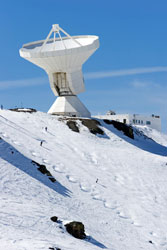Geo-mapping the snow
Accurate snow maps that provide information on a number of snow parameters like snow cover area, snow water equivalent, snow wetness and snow surface temperature are indispensable for a number of scientific fields. The fields of meteorology, hydrology, and geology all use snow data. Moreover, snow maps are expected to considerably aid in environmental protection. The ENVISNOW project has developed a software suite that integrates snow parameter retrieval algorithms and processes data accumulated from multiple sensors. Automated snow mapping is now feasible for both imaging radar and optical sensors. Software data processing enables classification of snow-covered areas utilising either backscattering information stemming from radar observations or multi-spectral reflectance signatures from optical sensors. The collected data may be projected in many different ways resulting in a number of respective maps. The developed software facilitates snow mapping from specific absorption rate (SAR) measurements. SAR sensors are capable of observing the Earth's surface without being affected by clouds or daylight but enable detection only for melting snow. Their data has numerous applications in hydrology and water management. The snow classification tool developed by the ENVISNOW partners was succesfully tested for SAR sensors on board a number of European satellites. Snow cover maps were also produced from both medium and high-resolution optical sensors. Once again, application and testing of the software tool was successful. Different observation geometries, sensor resolution and sensitivity to snow parameters between radar and optical equipment result in systematic differences of the respective maps produced. The developed tool can account for these systematic differences and eliminate them, enabling consistent mapping. The snow parameter retrieval algorithm integrates the complementary characteristics of optic and radar sensors. The resulting automated snow mapping is utilised in hydrological modes allowing better prediction accuracy.







